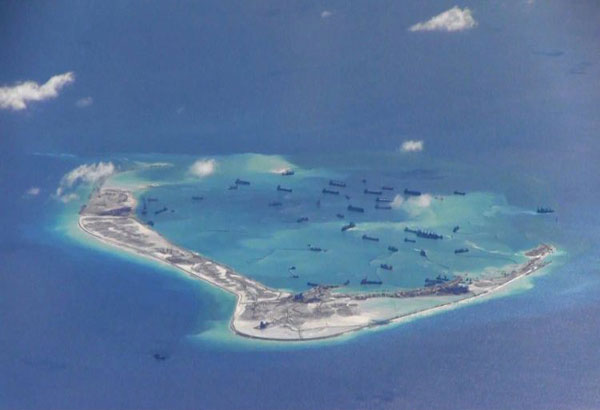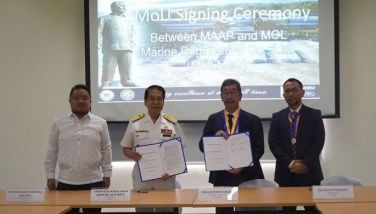US hits China on new SCS structures

US Secretary of State Rex Tillerson said the US now has an active mechanism through which Washington and China can put complex issues on the table including the South China Sea row. US Navy/File
MANILA, Philippines — Even as the Philippines has belied new Chinese activity in the oil-rich South China Sea, the United States last week called China’s continuing development of islands in the disputed waters “unacceptable.”
US Secretary of State Rex Tillerson said the US now has an active mechanism through which Washington and China can put complex issues on the table including the South China Sea row.
“And we have differences, such as the South China Sea and China’s building of structures, militarization of these structures, and how that affects our allies in the region as well in terms of free and open trade,” Tillerson said at the 2017 Atlantic Council-Korea Foundation Forum in Washington.
He said the US had stated to China that Washington was hopeful the two countries could find a way to freeze the building and militarization of structures in the South China Sea.
“Whether we can reverse, it remains to be seen,” Tillerson said. “But it’s not acceptable to us that these islands continue to be developed, and certainly not for military purposes.”
Foreign Affairs Secretary Alan Peter Cayetano downplayed on Friday the Washington-based think tank Asia Maritime Transparency Initiative’s latest report about the continued installation of facilities on man-made islands reclaimed by China in previous years.
He said the Chinese have not occupied or fortified new areas in the South China Sea, also referred to as the West Philippine Sea.
China, according to Cayetano, is not the only government conducting activities in areas being contested.
At the end of the 50th Association of Southeast Asian Nations Foreign Ministers’ Meeting and Related Meetings in Manila last August, he admitted that the Philippines did not want “militarization” and “land reclamation” in the South China Sea mentioned in the ASEAN Foreign Ministers’ joint communique, but Manila had to abide by the consensus of the majority in the regional group to reflect the wording in the statement.
Cayetano said he did not want to include militarization and land reclamation in the joint statement he “drafted.”
“Yes, I drafted it. I didn’t want to include it,” Cayetano confirmed in a press briefing at the International Media Center in Pasay City.
He explained that militarization and land reclamation were dropped in the statement because “it’s not reflective of the present position.”
“They’re not reclaiming land anymore. So why will you put it again this year?” Cayetano said, referring to China’s unilateral activities in the disputed waters.
The general statement of the ASEAN, however, was reclamation in the past and reclamation might start again, he said.
“But I accepted it. You start with a proposition so there is militarization in the area but there is also militarization outside. So every country has the right to defend itself,” he added.
Cayetano said it does not mean he agrees with Chinese activities but the Philippines, in building trust and mutual respect with China, asked Beijing to understand the consensus reached.
Last November, Cayetano thanked US President Donald Trump, calling him a “good” mediator and “master of the art of the deal,” for his offer to mediate in the South China Sea issue but said Manila believes a bilateral discussion on the disputes between the Philippines and China is “going very well.”
He said Trump’s offer has to be answered by claimant countries.
At the Asia-Pacific Economic Cooperation Chief Executive Officers Summit in Da Nang, Vietnam where he delivered a strong message, Trump called on nations to deal “decisively” on territorial expansion and threats to security.
He emphasized the importance of upholding the rule of law, freedom of navigation and overflight, a reference to China’s aggressive behavior in the South China Sea.
Free, open Indo-Pacific
Meanwhile, Tillerson reiterated the US’ call for a free and open Indo-Pacific that would ensure all countries’ trade access to and continue their economic development with the region.
While the “One Belt, One Road” is China’s economic roadmap and the US policies do not seek to contain China’s development, he emphasized that “China’s economic development, in our view, should take place in the system of international rules and norms.”
“(The) One Belt, One Road seems to want to define its own rules and norms,” Tillerson said.
Th US’ top diplomat quoted US Defense Secretary James Mattis’ comment on why the US is opposed to the One Belt, One Road policy: “The US and the rest of the world has many belts and many roads, and no one country gets to decide what they are. So a free and open Indo-Pacific means all countries have access to continue their economic development and free access for trade through the region.”
“The One Belt, One Road also goes through disputed territory, and I think, that in itself shows the vulnerability of trying to establish that sort of a dictate,” Mattis also said.
The One Belt, One Road initiative, valued at about $1 trillion, aims to get some 60 countries to invest in infrastructure projects to develop land and maritime routes following the old Silk Road network that once connected China to Central Asia and Europe.
- Latest
- Trending































